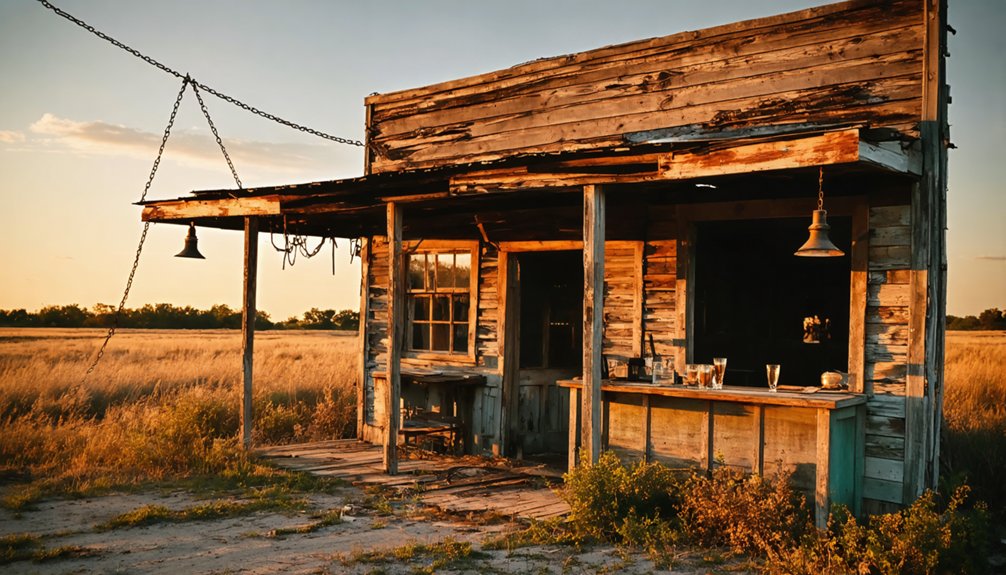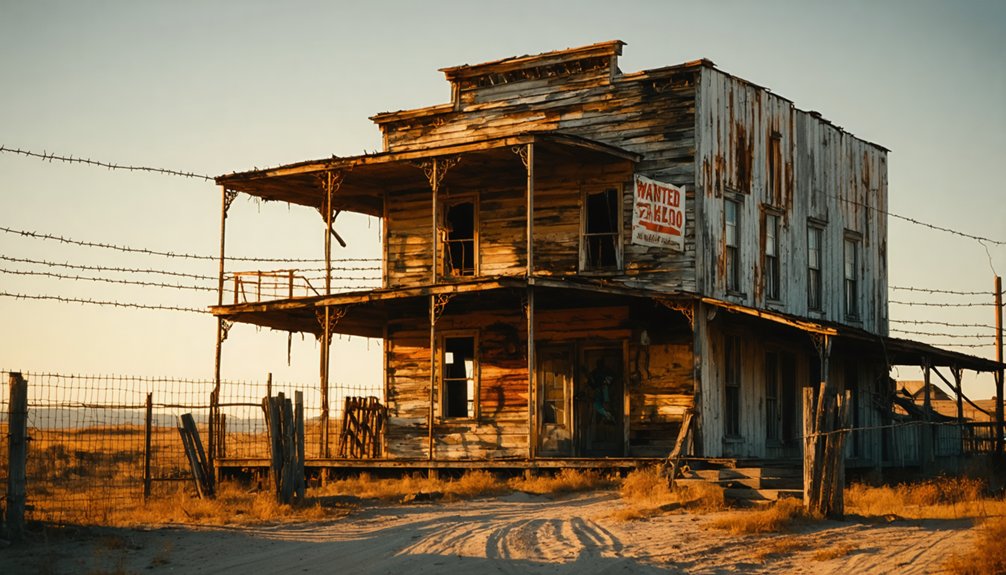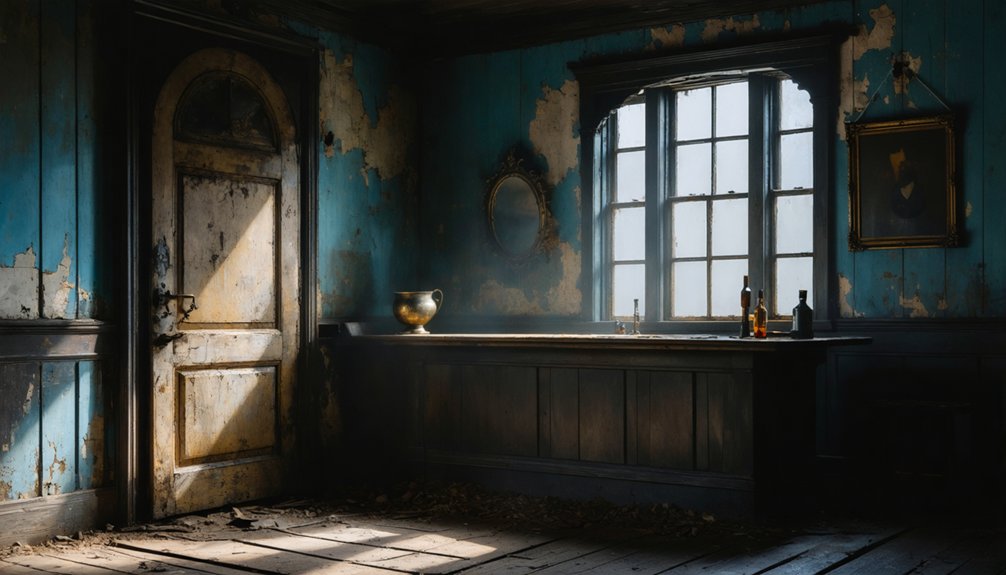Wyoming boasts over 100 abandoned settlements that showcase the boom-and-bust cycle of mining history. You’ll find well-preserved sites like South Pass City with its restored Carissa Mine alongside vanished communities like Carbon, which once housed 1,500 residents. Accessing these remote locations requires 4×4 vehicles, offline maps, and essential supplies. Photograph textured weathered buildings, mining equipment, and dramatic landscapes to capture their haunting stories. The hidden foundations and rusted relics await your discovery.
Key Takeaways
- Wyoming’s abandoned mining towns like Carbon and Rock Springs reflect the boom-bust cycle of Western resource extraction communities.
- South Pass City offers a preserved gold rush experience with restored buildings and the historic Carissa Mine.
- Ghost towns require 4×4 vehicles to access, with visitors needing offline maps and emergency supplies for remote exploration.
- Photography enthusiasts should prepare weather-sealed cameras and protective gear for capturing abandoned architecture and mining equipment.
- Once-thriving communities like Carbon, Glencoe, and Acme were abandoned when mines closed or railroads rerouted.
The Rise and Fall of Wyoming’s Mining Boomtowns
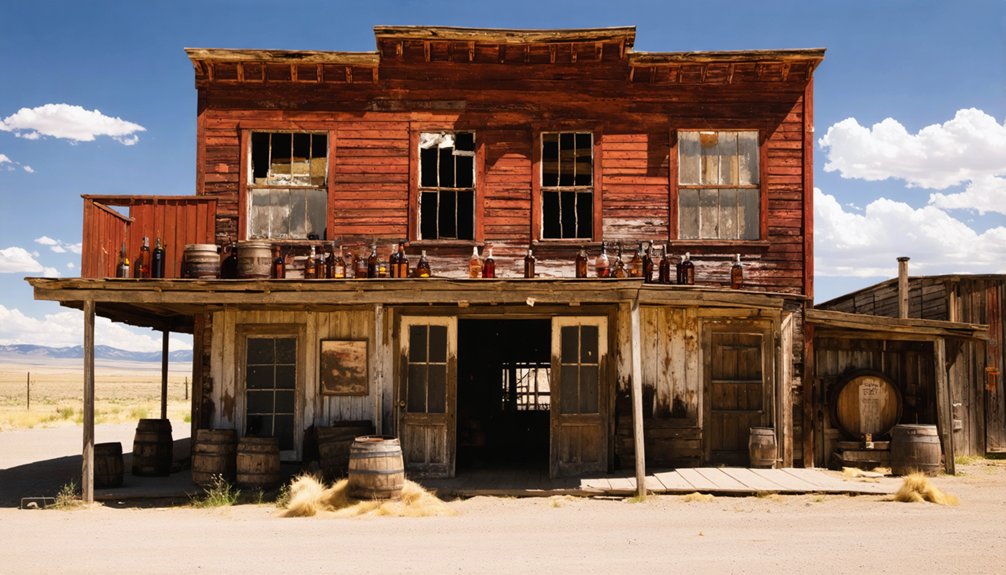
When the Union Pacific Railroad arrived in Wyoming in 1867, it triggered the birth of numerous mining boomtowns that would dramatically shape the territory’s development.
Commercial coal operations quickly emerged to fuel steam locomotives, with companies like Wyoming Coal and Mining establishing the first operations before Union Pacific seized monopoly control after 1874.
You’ll find that mining techniques evolved from small underground operations to massive open-pit excavations by the 1950s, drastically reducing workforce needs.
The economic impact of these shifts was profound—towns like Carbon and Rock Springs initially thrived, producing over 11.9 billion tons of coal through 2018.
However, when mines became unprofitable, entire communities vanished. Company-owned coal camps left residents vulnerable to eviction during downturns, creating a legacy of resilient but ultimately transient communities across Wyoming’s landscape. Mining towns such as Glencoe, Sublet, and Acme were among the abandoned mining towns as companies dismantled camps to avoid property taxes.
The town of Carbon, once home to approximately 3,000 residents with seven operational mines, was completely abandoned by 1902 after the railroad was relocated and the mines closed.
Carbon: From Railroad Hub to Ghostly Foundations
As the Union Pacific Railroad pushed westward in 1868, Carbon emerged as one of Wyoming Territory’s earliest and most essential coal towns, strategically established along the still-under-construction transcontinental railroad line.
Named for its crucial resource, Carbon’s significance stretched beyond mere extraction—its seven mines fueled locomotives struggling up Simpson Ridge’s steep grades, directly enabling transcontinental rail travel. Initially, the town was a disorganized collection of rough cabins and dugouts.
At its peak, this rugged community housed over 1,500 people and embodied the frontier’s harsh realities, including labor tensions that culminated in vigilante justice and strikes. The town suffered from serious health issues due to limited water supply, with water transported via railroad tank cars and stored in potentially dangerous cisterns.
Carbon’s mining legacy ended abruptly when Union Pacific rerouted its mainline in 1899, favoring nearby Hanna. By 1902, the mines closed permanently, and by 1908, only 15 residents remained.
Today, you’ll find only scattered foundations and the original cindered railbed marking Wyoming’s first coal town.
South Pass City: Gold Rush Legacy Preserved

Unlike many boom-and-bust mining settlements that vanished without a trace, South Pass City stands as Wyoming’s most authentic preserved gold rush town.
The 1860s gold discovery near South Pass triggered rapid development, with miners flocking to extract riches from claims with colorful names like King Solomon and Caribou. The June 27, 1867 arrival of Lewis Robison and his associates in Salt Lake City with 40 ounces of gold dust helped spark the rush to the region. The rush was further fueled by extensive coverage in Union Vedette newspapers, which attracted prospectors from across the country. You can still witness the evolution of mining technology at the restored Carissa Mine and stamp mill, which once crushed quartz to extract precious metals.
Today, as a Wyoming State Historic Site featuring 24 original structures and 30 room exhibits, South Pass City offers a tangible connection to frontier life.
When you visit during Gold Rush Days each July, you’ll experience historical reenactments that capture the spirit of those who risked everything for golden opportunities.
Accessing Remote Ghost Towns: What You Need to Know
The journey to Wyoming’s ghost towns demands careful preparation beyond what’s required for visiting preserved sites like South Pass City.
You’ll need a 4×4 vehicle for unpaved roads to remote locations like Kirwin, which is only accessible July through September due to mountain weather conditions.
When planning your expedition, prioritize safety precautions: wear sturdy boots and protective clothing, carry emergency tools, and avoid unstable structures.
Navigation tips include downloading offline maps, as GPS often fails in these isolated areas. Remember that cell service is virtually nonexistent.
Always respect posted boundaries, especially at sensitive historic sites. Most ghost towns prohibit camping within their limits, though nearby public lands may permit it.
Bring ample water, food, and fuel—there are no amenities in these forgotten outposts of the American frontier.
Consider making Casper your central base location for ghost town explorations, as it provides convenient access to numerous abandoned settlements across Wyoming.
Gebo, once a thriving mining community named after Samuel Gebo, offers visitors a glimpse into Wyoming’s coal mining boom of the early 1900s.
Photographing Wyoming’s Abandoned Architecture
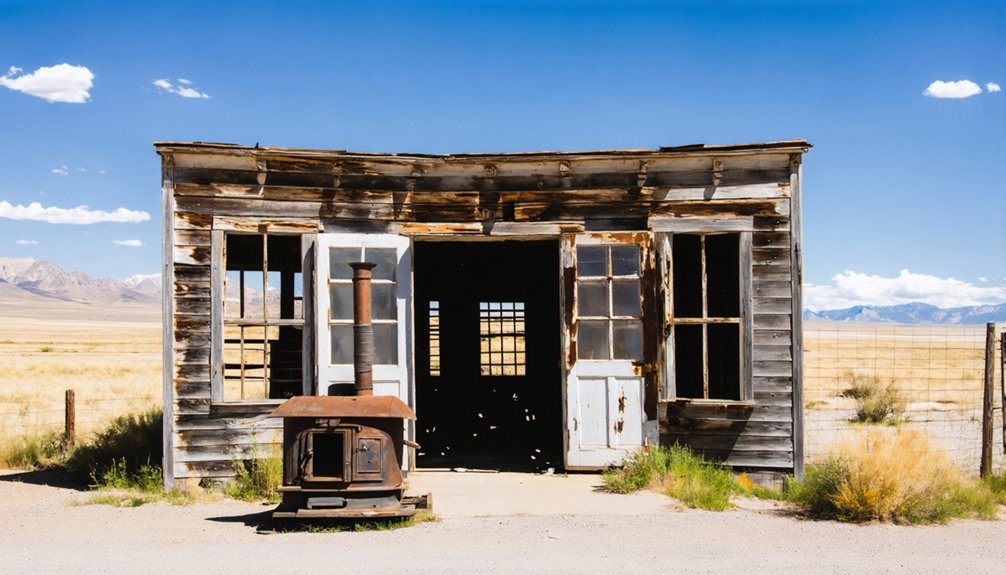
Wyoming’s abandoned architecture offers unique photographic opportunities where you’ll find dramatic interplays of light and shadow revealing the passage of time across weathered wood and stone surfaces.
Your equipment requires adaptation to the harsh Wyoming climate, including tripods for stability during high winds and protective gear for cameras during dust storms or sudden snowfall.
Capturing these frozen moments in time demands both technical skill with wide-angle lenses for contextual shots and macro capabilities for detailed textures that tell the story of the American West’s impermanence. Both Driese and Ng have dedicated themselves to documenting these places through visual storytelling rather than extensive historical research.
Visitors to Point of Rocks Stage Station can photograph one of the most well-preserved structures from Wyoming’s stagecoach era, offering a glimpse into 19th-century transportation history.
Light and Shadows Play
Capturing the haunting beauty of abandoned architecture across Wyoming’s ghost towns requires mastering the interplay of light and shadows during specific times of day.
You’ll find the golden hour—early morning and late evening—creates dramatic contrast as low-angle sunlight strikes weathered facades while casting deep shadows across deteriorating structures.
Wyoming’s high elevation intensifies this directional light, transforming ordinary ruins into compelling visual narratives. Shadow patterns from log cabins and mining equipment add dimensional depth to your compositions, while backlighting enhances texture on crumbling stone walls in places like Jibo.
Strategic positioning allows shadows to act as leading lines toward focal points in Dillon ghost town.
For alternative perspectives, consider night photography, where moonlight silhouettes abandoned buildings against star-filled skies or use headlamps to reveal texture details invisible during daylight.
Captured Moments in Time
Frozen in weathered wood and crumbling stone, Wyoming’s abandoned architecture offers photographers unparalleled opportunities to document America’s frontier legacy before time erases these historical treasures completely.
As you frame your shots, incorporate contextual elements like rusted mining equipment or weathered signage to enhance the narrative behind ghost town legends. Focus on capturing the textures that tell stories—splintered floorboards where pioneers once walked and faded advertisements on mercantile walls.
Historical preservation efforts sometimes stabilize structures at sites like Kirwin, where Amelia Earhart’s planned cabin stands incomplete.
When shooting these buildings, emphasize architectural lines that reveal 19th-century craftsmanship. Consider wide-angle compositions that showcase how these settlements existed within their harsh environments, simultaneously conveying isolation and the human determination that briefly conquered these remote landscapes before nature reclaimed them.
Equipment for Harsh Conditions
The unforgiving Wyoming wilderness demands photographers come prepared with equipment engineered to withstand extreme elements when documenting ghost towns. Weather-sealed cameras like the Canon EOS R7 or Nikon Z7 II offer reliable protection against dust storms and sudden mountain rainfall that frequently challenge explorers of these forgotten settlements.
- Implement gradual warming techniques to prevent condensation damage when moving from frigid dawn shoots to heated vehicles.
- Carry protective filters to shield lenses from airborne sand that pervades abandoned structures.
- Pack insulated camera bags to maintain ideal operating temperatures during temperature fluctuations.
- Utilize remote shutter releases for stable long exposures in windy conditions.
For non-weather-sealed equipment, simple solutions like plastic covers or freezer bags provide essential camera protection during unexpected weather challenges, ensuring your documentation efforts aren’t compromised by Wyoming’s notoriously unpredictable climate.
Mining Relics and Historic Artifacts: What Remains
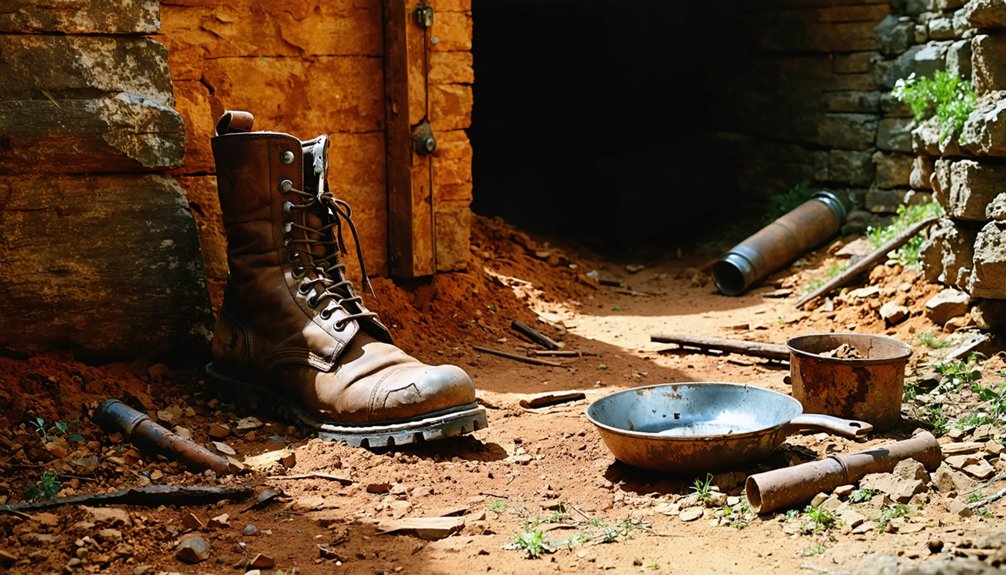
Relics of Wyoming’s industrial past remain scattered across abandoned mining towns, offering tangible connections to the state’s extractive heritage.
You’ll discover over 7,000 artifacts recovered from sites like Sunrise, where CF&I operations inadvertently preserved Paleoindian materials through industrial activities. Mining techniques are documented through abandoned infrastructure, including railroad tracks between Sunrise and Hartville.
Archaeological treasures hide in plain sight among industrial ruins, where modern extraction preserved ancient human stories.
The artifact significance extends beyond industrial remnants to include extraordinary archaeological treasures.
The Powars II site—North America’s only known Paleoindian red ochre mine—yielded an unprecedented 80+ Clovis points spanning 16,000 years of human activity.
Ghost towns like Gebo stand as weathered monuments to coal mining’s boom-and-bust cycle, their structures silently narrating Wyoming’s resource-driven past while challenging established chronologies of early human presence.
The Role of Natural Disasters in Town Abandonments
As you explore Wyoming’s ghost towns, you’ll discover that natural disasters have dramatically altered the trajectory of numerous settlements, with the 1907 avalanche that crushed Kirwin serving as a prime example of how nature could swiftly end a community’s viability.
The catastrophic forces of fire similarly erased several promising settlements, with flames consuming wooden structures and leaving little for prospective residents to salvage or rebuild.
These environmental calamities—from snowbound tragedies to devastating conflagrations—often provided the final impetus for mass exodus, transforming once-thriving communities into the abandoned relics you encounter today.
Snowbound Tragedies
Natural disasters, particularly devastating snowstorms and avalanches, played a pivotal role in the abandonment of numerous Wyoming frontier settlements. The 1907 avalanche that killed three Kirwin residents exemplifies how snowstorm legacies permanently altered town trajectories.
At elevations approaching 8,000 feet, settlements like Eadsville confronted existential challenges from winter’s fury.
You’ll find avalanche impacts extended beyond immediate casualties:
- Transportation networks collapsed as snow-choked mountain passes severed critical supply lines
- Mining operations became economically nonviable when winter isolation drove operational costs skyward
- Wooden structures deteriorated rapidly under persistent snow loads
- Emergency response capabilities vanished during months-long periods of isolation
Without modern mitigation infrastructure, these settlements remained perpetually vulnerable.
When economic factors eventually compounded these environmental challenges, residents abandoned their communities, leaving behind silent monuments to frontier ambition crushed beneath Wyoming’s merciless winter weight.
Fiery Town Deaths
While winter’s fury claimed numerous Wyoming settlements, fire emerged as an equally devastating force that permanently altered the state’s frontier landscape.
You’ll find evidence of this destructive pattern in Wyoming’s ranking as second among Lower 48 states for fire risk exposure. The 1903 Hanna No. 1 mine explosion exemplifies such fire tragedy, killing 169 miners when coal gas ignited, leaving an underground fire that burned for days and hampered disaster recovery efforts.
Wildfire threats have only intensified over time. The 1937 Blackwater Creek fire claimed the lives of Ranger Clayton and six firefighters when sudden 45 mph winds created an inescapable firestorm.
More recently, Wyoming’s landscape continues to face escalating burn patterns, with over 1.2 million acres consumed between 2002-2013, pushing many struggling settlements toward abandonment.
Planning Your Wyoming Ghost Town Road Trip

Starting on a ghost town expedition across Wyoming requires meticulous planning to navigate the state’s vast, rugged landscape effectively. Research suitable routes connecting historic sites along major highways like US-287 and US-26, while developing road trip itineraries that account for seasonal accessibility.
Ghost town preservation efforts have made sites like South Pass City more visitor-friendly, while others remain authentically untouched.
Before departing, verify you’ve:
- Acquired detailed maps showing remote locations, particularly for sites requiring forest service road travel
- Packed emergency supplies including extra water, food, and first-aid equipment
- Researched access restrictions, as many sites lie on private property
- Prepared for rapid weather changes with appropriate clothing and gear
Travel between late spring and early fall when mountain roads are reliably passable and historic structures are fully visible.
Frequently Asked Questions
Are There Any Ghost Towns With Reported Paranormal Activity?
Yes. You’ll encounter numerous paranormal investigations in Kirwin, where visitors document voices and eerie atmospheres. Gebo’s haunted legends include children’s cries from the graveyard, reflecting Wyoming’s tragic mining town history.
Can Visitors Legally Collect Artifacts From Wyoming Ghost Towns?
No, you can’t legally collect artifacts from Wyoming ghost towns. Artifact regulations prohibit removal from public lands without proper permits, and violations carry serious legal implications including fines and criminal charges.
Which Ghost Towns Are Accessible During Winter Months?
Most Wyoming ghost towns have limited winter accessibility. You’ll need specialized transportation for Garnet (Montana), while Gebo may be reachable with 4WD vehicles depending on ghost town conditions.
How Do Local Tribes View These Abandoned Settlements?
You’ll find tribal perspectives on abandoned settlements often emphasize their historical significance as symbols of dispossession. Eastern Shoshone and Northern Arapaho view these sites through lenses of broken treaties and territorial loss.
Are Any Ghost Towns Being Considered for Revitalization Projects?
Like broken clocks finding new life, you’ll observe revitalization efforts in Superior—transformed into a “living ghost town”—while historical preservation initiatives sustain Miner’s Delight, South Pass City, and Jibo through carefully managed development.
References
- https://www.wyomingcarboncounty.com/blog/123-5-ghost-towns-to-explore
- https://sites.rootsweb.com/~wytttp/ghosttowns.htm
- https://www.youtube.com/watch?v=GEoxbcwf8Ks
- https://www.yellowstonepark.com/things-to-do/attractions/ghost-town/
- https://www.explorewy.com/blog/ghost-towns-halloween-southwest-wyoming-travel
- https://www.geotab.com/ghost-towns/
- https://en.wikipedia.org/wiki/List_of_ghost_towns_in_Wyoming
- https://www.onlyinyourstate.com/experiences/wyoming/creepy-ghost-towns-in-wy
- https://www.wyohistory.org/encyclopedia/wyomings-first-coal-bust
- https://www.wyohistory.org/encyclopedia/coal-business-wyoming

